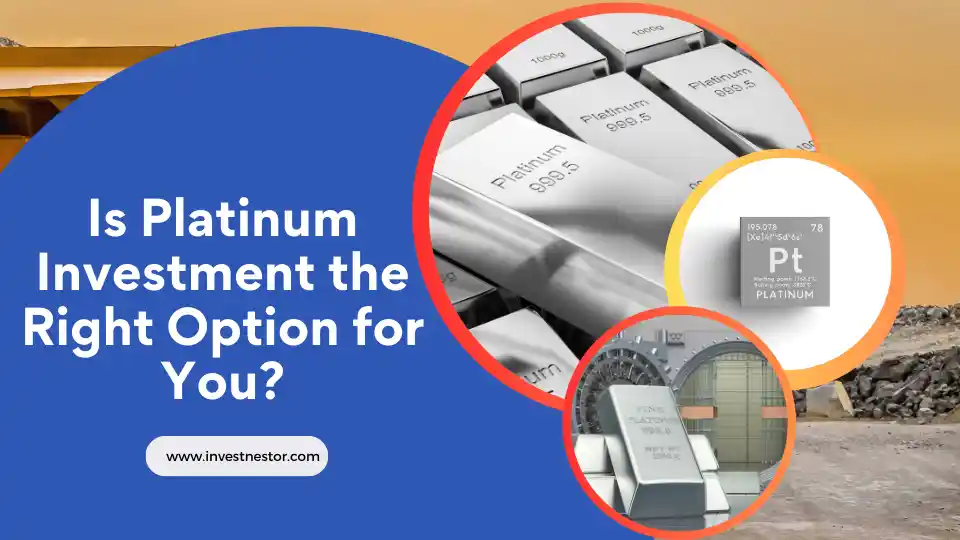
Platinum Investment: How to Invest, Pros & Cons
Have you considered investing in Platinum, a highly valuable metal? Platinum is one of the rarest elements and is desired for its qualities. Platinum has outpaced gold and is a promising diversification option. This article will discuss why Platinum should be in your investment plan, how it has performed, where experts anticipate its value will go in the next years, its benefits and downsides, and if it's better than gold. After this, you'll know if Platinum is a good investment.
How to invest in Platinum?
A valuable metal like Platinum ought to be included in each investing portfolio. This is how to invest in Platinum and the reasons it should be part of your portfolio:
-
Investing in Platinum may be done directly by buying platinum bars, coins, or jewelry. Platinum bars and coins are available from precious metal dealers and some banks. Jewelry allows you to own Platinum and is an attractive item to wear. However, platinum jewelry typically has high markups, and the value of the Platinum is often less than the price. But the value of Platinum is sometimes less than the amount you pay, and platinum jewelry usually includes significant markups.
-
Exchange-traded funds (ETFs) and mutual funds that track platinum prices are excellent choices for anyone wishing to invest in the metal without owning it. You may purchase shares in platinum ETFs through a brokerage company that tracks the price of Platinum. Platinum mining stocks are another possibility.
-
As the value of Platinum rises, mining companies stand to profit, and their stock prices also often increase. Platinum has outperformed gold over the long run. While Platinum is more volatile, it has averaged higher returns. If you have a long investment time horizon, Platinum's volatility won't matter as much, and you'll benefit from its potential higher returns.
Is Platinum a good investment?
-
Platinum prices have surged during political or economic uncertainty since it's seen as a "safe haven" investment. When stock markets are volatile, or inflation rises, Platinum can significantly outperform other assets.
-
Platinum is hard to mine and refine. South Africa accounts for over 70% of world supply, so any disruptions there can cause prices to spike. Environmental regulations and labor disputes frequently impact production. New platinum discoveries are very limited, so future supply may not keep up with increasing demand.
-
Although more volatile than gold, Platinum may yield larger long-term returns. Over the previous 20 years, Platinum has returned 10% yearly, while gold has returned 7.5%. Platinum might rise 30% or more if the global economy recovers in the next years.
-
Of course, not everyone likes Platinum. Short-term riskier than gold or silver. Platinum should be on your radar if you want to expand your precious metals portfolio. Adding just a small allocation, 5-10 % of your metals holdings, could significantly boost your returns over the next 5-10 years.
How has Platinum performed?
-
Platinum has always been a top performer. Platinum has outpaced gold for 20 years. From 2000 to 2020, platinum prices rose over 260% compared to gold's increase of about 370%.
-
While Platinum is more volatile than gold due to its smaller market and industrial uses, it has the potential for higher returns during economic growth and stability. Platinum's high demand in the automotive and jewelry industries, as well as its scarcity, help support its value.
-
The largest source of platinum demand is in catalytic converters for vehicles to reduce emissions. Platinum helps convert carbon monoxide, hydrocarbons, and nitrogen oxides into less harmful emissions before they leave the exhaust system. As environmental regulations tighten and vehicle sales climb, platinum benefits.
-
While Platinum will likely remain volatile, its strong industrial uses and precious metal status are positives for long-term value. As the economy recovers from 2020 and vehicle sales rebound, Platinum has significant room to rise.
What are the advantages and disadvantages of Platinum Investment?
Investing in Platinum has some appealing advantages and potential downsides to consider.
Upside: Precious and Rare
Platinum is one of the rarest precious metals, even more scarce than gold. This inherent rarity gives Platinum an advantage over other investments. As supplies dwindle and demand rises, platinum prices will likely increase. Platinum is seen as a stable store of value by many investors.
Upside: Industrial Demand
Platinum is essential for many industrial applications like catalytic converters in vehicles and various chemical processes. As emerging market economies grow, the need for Platinum in manufacturing and vehicle production is projected to rise. This steady industrial demand helps support platinum prices.
Downside: Volatility
Platinum is a good long-term investment, but its short-term price volatility depends on the market and economy. Platinum prices dropped 60% during the 2008 financial crisis. Since platinum prices decline quickly, you must keep it for the long term.
Downside: Higher Premiums
Platinum typically has higher premiums over the spot price than gold when buying physical platinum bars or rounds. The higher cost of production and supply constraints lead to steeper premiums that can cut your potential returns, especially if you hold for longer.
Downside: Less Liquid
Platinum is less desirable than gold, making it harder to purchase and sell quickly. If you need to sell Platinum quickly, you may have to accept less money because finding buyers and sellers may take longer. For this reason, Platinum is often seen as an investment for patient investors with a long-term time horizon.
What will Platinum be worth in 5 years?
The current estimate for the long term suggests that Platinum will cost $900 in 2023 and $1,200 in 2024. By 2025, Platinum is expected to hit $1,500.
- $2,000 in 2026
- $2,200 in 2027
- $2,500 in 2028
- $2,700 in 2029
- $3,000 in 2030
- $3,500 in 2032
- $4,000 in 2034
While it's difficult to forecast a commodity's price five years out, Platinum is well-positioned for growth in the medium run. Several factors point to Platinum being worth significantly more in 2026:
Limited supply.
Platinum is scarcer than gold. Most Platinum originates from South Africa, where mining is difficult. Labor disagreements, power outages, and mineral depletion threaten supplies. Platinum prices should grow as mining becomes difficult.
Increased demand.
Vehicle emission-reducing catalytic converters need Platinum. As global environmental rules tighten, platinum demand will rise. Other industries, including petroleum refining, glassmaking, and medical equipment, use the metal. New technologies like platinum-based hydrogen fuel cells may increase demand.
The inflation hedge.
Platinum, like gold, retains its value throughout inflation. Platinum provides a rare, durable, hard asset when governments issue more money. When inflation rises, investors buy precious metals, raising prices.
Market mood.
Investor interest in Platinum fluctuates with market and economic conditions. Platinum rises as investors expect global expansion. Investors seek "safe haven" assets like Platinum during geopolitical upheavals and recessions.
Which Is it better to invest in, Platinum or gold?
Over the next five years, most industry analysts project platinum prices to rise due to limited supply and increasing demand for Platinum in catalytic converters and industrial applications. Supply constraints from mining in South Africa and strong demand from China and emerging markets will likely support higher platinum prices.
Platinum offers portfolio diversification since it has a low correlation with stocks and other assets. It provides a hedge against inflation and currency devaluation. However, Platinum is more volatile and illiquid than gold. For most investors, having a mix of both Platinum and gold is a good strategy. Platinum provides growth potential, while gold offers stability. With its unique properties, Platinum deserves to shine in your portfolio.
The Bottom Line
So, in summary, Platinum deserves a place in any well-diversified investment portfolio. While volatile, Platinum has solid long-term growth potential and provides an inflation hedge. The key is to invest for the long haul rather than for a quick buck. Do your research, find a reputable broker, and start building your platinum investment today. Years from now, you'll be glad you secured this precious metal before prices head to the moon.
Suggested Articles:





0 Comments
Add a comment